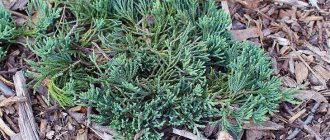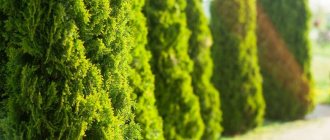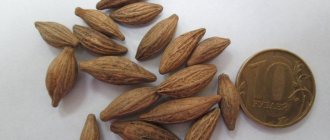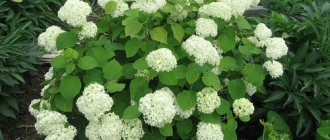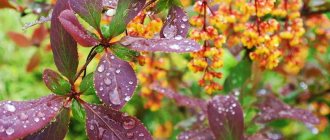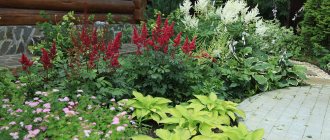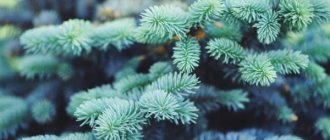Landscape design involves the use of a variety of plant species to arrange a personal plot. Honeysuckle is very popular among landscape designers. This is an ornamental garden bush from the family of the same name. Varieties of honeysuckle can be different, and therefore the bush can be erect, creeping or climbing. It is this diversity that has made this type of plant very popular, as it allows you to create a wide variety of compositions.
It is worth adding that honeysuckle also comes in a berry variety, and honeysuckle berries are no less useful than the fruits of other well-known shrubs. Let's take a closer look at what honeysuckle is and how it is used in the landscape.
Use in landscape design
Honeysuckle in landscape design is known for its unique adaptive abilities. The shrub is able to develop well even in shaded areas. Using correct and timely pruning techniques, designers give the plant absolutely any shape.
Captivating dream - this is how the name of the shrub is translated from Latin, and is characterized by the presence of numerous small flowers of various shades.

In its wide variety of varieties, “captivating dream” is used to decorate garden buildings, arches, hedges, etc. structures. For the most part, the picturesque forms of honeysuckle are unpretentious, feel great in the vicinity of other garden and vegetable crops, and are easy to care for. In landscape design, it is allowed to plant several varieties of plants in one area, differing not only in configuration and height, but in methods of reproduction and flowering.
Feeding honeysuckle honeysuckle
How to feed honeysuckle in the fall? So, in order for the plant to bear lush greenish foliage and fruits, it should be fed with organic fertilizers every 3-4 years. Humus, fertilizer, manure or chicken manure will come in handy here.
Carrying out loosening and weeding. As a rule, after watering the base around the bushes should be loosened. In addition, it is necessary to eliminate all weeds without exception. When caring for shrubs in autumn, do not remove leaves from the ground near the root system. This way it can help the bush survive frost, and in addition provides auxiliary food.
Compatibility with other plants and interior items
To form a unique picture of the landscaped area, it is necessary to use not only the variable diversity of vegetation in height, shape and color, but also to take into account the need to correctly select the species palette. Thanks to the latter, you can harmonize the surrounding space. If we talk about the decorative properties of honeysuckle, then vines are an ideal option for decorating vertical supports, arched structures, fences, low buildings, terraces, as well as trellises, stairs, etc. The most picturesque effect can be achieved by creating combined plantings. The most beneficial neighbors for honeysuckle can be coniferous shrubs and roses with long shoots, creeping or arched.
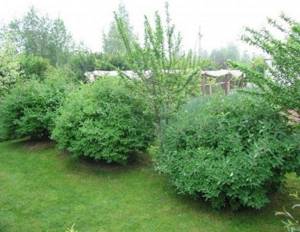
When forming a new image of the territories, the ability of colorful honeysuckle to be an ideal material for decorating walls and creating hedges is taken into account. Dwarf plant varieties look great in the format of rocky gardens, alpine hills and mountain slopes. Experts also use the delightful aromatic properties of honeysuckle: certain varieties form special aromatic zones.
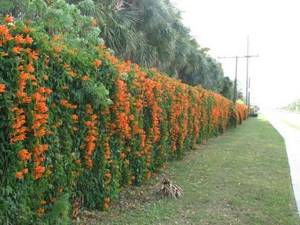
Experts successfully form spectacular natural compositions, combining a “captivating dream” with hawthorn, cherry plum, hazel, Iberis and other plants.
Do not forget that the shrub also looks impressive in single plantings.
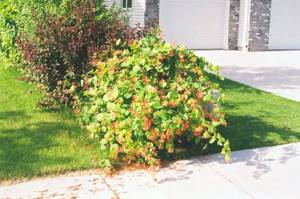
When thinking about the formation of a new look for territories, it is worth remembering that honeysuckle is a grateful material for a creative approach. With the right choice of type, you can create unique compositions from:
- erect shrubs (common honeysuckle, Tatarian, blue, Maaka, shiny and fragrant, blanket, alpine);
- climbing plants (Caprifol, Japanese, Brown, Thälmann, climbing, Etruscan, Gecrotta).
Subspecies and varieties
The following types and varieties of shrubs are successfully used in landscape design:
Among the evergreen shrubs, characterized by low winter hardiness, but remarkable decorative properties, are brilliant honeysuckle, Maigrun and Elegant. They adapt well to pruning, are often used in hedges, and look great on the banks of ponds and as a frame for garden paths.
Kamchatka honeysuckle is a long-lasting, frost-resistant, unpretentious shrub. Looks impressive in compositions with fruit and ornamental plants.
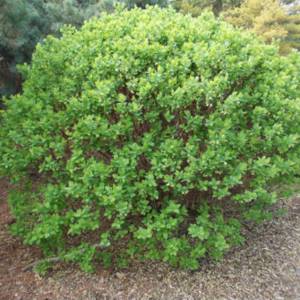
Kamchatskaya
Climbing honeysuckle is a vine used to transform arbors and fences. It is distinguished not only by its shape, but by its abundant flowering, bright green color of leaves and orange color of edible fruits. The decorative forms are called Aurea, Belgica and Serotina.
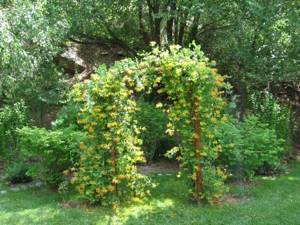
Curly
Tatarian honeysuckle is a shrub used to form hedges. In spring, the bush, stretching up to 4 meters, blooms for a long time in soft pink shades. And after flowering, red-orange fruits are formed. Its unique feature is its bluish leaves. Looks great in group compositions.

Tatar
Honeysuckle honeysuckle is a climbing, picturesque shrub that grows up to 6 meters, has inedible but very aromatic fruits and the ability to transform objects in any area. The peculiarity of the variety is that it is sun-loving, requiring support, a permanent planting site, moist soil and regular fertilization. Among the cultivated forms, Alba and Pauciflora stand out.

Honeysuckle
Brown's honeysuckle is a hybrid deciduous vine with fragrant, profusely blooming inflorescences. Used in vertical gardening and as a ground cover plant. Famous varieties include Fuchsioides and Dropmore.
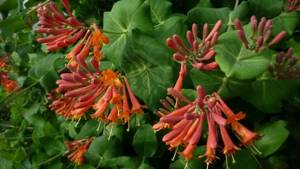
Brown
Among the hybrid varieties, it is worth highlighting Gecrotta, Thälmann and American honeysuckle.
Harvesting
The ripening of berries occurs quite early for the middle zone - already by the end of June or at the beginning of the next month. A sign of ripeness is a rich and even color over the entire surface of the fruit. However, not all varieties are able to hold the crop on the branches without dropping it to the ground. Therefore, it is recommended to spread a film under the bush in advance, and then periodically pour clean berries from it into a container. It should be remembered that they wrinkle very easily and are not stored for a long time. Therefore, the container should be wide and low, and the processing of fruits or their consumption should be quick.
Care, planting and propagation
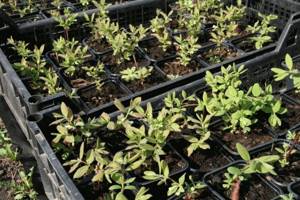
Honeysuckle is used in landscape design due to its ability to withstand frost. This fact indicates that there is no need to cover the shrub for the winter.
Climbing species require reliable support for proper growth.
The plant must be pruned in a timely manner. In the absence of proper care, the vine may lose its attractiveness and ability to delight with fragrant flowers.
It is worth paying attention to the pruning process: excessive enthusiasm will allow you to enjoy large flowers, but not for long.
You cannot prune in the spring, otherwise the growth process of the lashes will be stopped until next year.
To quickly propagate honeysuckle, designers prefer to use layering, which is easier and faster, and cuttings, which require greenhouse conditions for rooting. The first method is applicable for flexible varieties, and the second for those that are not flexible.
You can grow a shrub from seeds and thanks to root shoots.
Diseases are rare. Among the most common ones is a fungus that develops in high humidity conditions. Insect pests - aphids.
It is necessary to plant seedlings in well-lit areas in September-October on neutral soils of moderate humidity. It is necessary to follow the planting rules, which require maintaining a distance between seedlings of at least one and a half meters, followed by abundant watering of the soil and mulching.
Honeysuckle is one of those plants that nature created for vertical gardening. Fast growth, abundant flowering, decorative fruits, an attractive aroma and endless possibilities for design imagination - all this allows you to create not only complex landscape compositions, but also to improve the territory of your personal plots.
Honeysuckle Honeysuckle
Honeysuckle honeysuckle is a beautifully flowering liana-like shrub with shoots up to 4 - 6 meters long. This plant has broad oval dark green leaves; they are located on the stem in pairs, opposite; the leaves retain their color until late autumn and are among the last to fall in the garden (translated from Latin, “honeysuckle” means “goat leaf” (apparently, goats are not averse to feasting on the leaves of this shrub). Honeysuckle flowers collected in bunches are very attractive, they are quite large, tubular, with far protruding stamens, collected in bunches. On the outside, the flowers have a pale cream color, gradually (day by day) turning pink; on the inside they are white or slightly yellowish. The pleasant delicate aroma of honeysuckle honeysuckle intensifies in the evening, with sunset; by the beginning of the day it weakens.
The first honeysuckle flowers usually bloom in early June; The flowering of the plant lasts almost the entire month of June. Subsequently, in place of the flowers, fruits ripen - orange-red berries, as if glued to the leaves.
Honeysuckle honeysuckle is perfect for vertical gardening (this crop, by the way, is loved in many European countries).
Climbing shrubs with dense foliage and elegant flowers decorate the fences; walls of houses, decorate outbuildings, baths, toilets with the help of honeysuckle honeysuckle make gazebos, terraces, porches more beautiful and cozy.

Honeysuckle honeysuckle is a fast-growing, durable plant, lives up to 50 years, unpretentious, drought-resistant, frost-resistant (does not need shelter for the winter). Honeysuckle tolerates urban conditions - gas and smoke resistant; lends itself well to pruning (with the help of formative pruning, the bush is given the desired shape (and maintained), and also: it rejuvenates the plant and enhances flowering. Pruning is the most important condition in the decorative appearance of this climbing plant.
Honeysuckle is easily propagated: by seeds and vegetatively (by layering, cuttings). Green cuttings are usually cut and rooted in early July. Plants begin to flower, as a rule, at 3–4 years of age.
Honeysuckle honeysuckle tolerates partial shade, but in sunny areas with fairly fertile, moist soil it blooms more profusely
Important note: so that over time this wonderful vine does not turn into a tangled, untidy lump, you need to immediately provide the plants with strong (and, it would be nice, beautiful support). These could be stakes (preferably not very shaky), lattice trellises, cords stretched in any desired direction; A large mesh nylon net is suitable
It should be taken into account that honeysuckle honeysuckle stems twist counterclockwise. When the stems have reached the required length, the top is cut off, thereby stimulating the development of lateral shoots.
Watch the video online: honeysuckle in the garden
In preparing today’s broadcast, materials from the book “100 Best Plants for Your Garden” and magazines were used: “Floriculture”, “Flower Gardens”, “In the World of Plants”, “Favorite Dacha”, “Do-It-Yourself Garden”.
